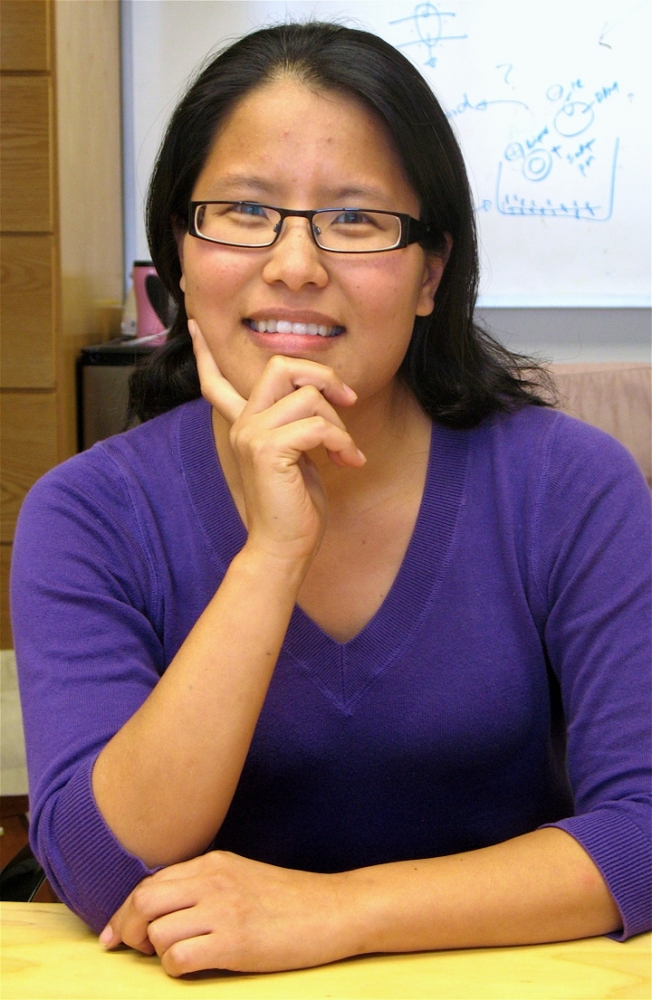
Boosted Signal

First introduced into wide use in the middle of the 20th century, nuclear magnetic resonance (NMR) has since become an indispensable technique for examining materials down to their atoms, revealing molecular structure and other details without interfering with the material itself.
“It’s a broadly used technique in chemical analysis, materials characterization, MRI — situations in which you do a non-invasive analysis, but with atomic and molecular details,” said UC Santa Barbara chemistry professor Songi Han. By placing a sample in a strong magnetic field and then probing it with radio waves scientists can determine from the response from the oscillating nuclei in the material’s atoms the molecular structure of the material.
“However, the problem with NMR has been that because it’s such a low-energy technique, it’s not very sensitive,” Han said. “It’s very detailed, but you don’t get much signal.” As a result, large amounts of sample material may be needed relative to other techniques, and the signals’ general weakness makes NMR less than ideal for studying complex chemical processes.
One remedy to this situation lies in dynamic nuclear polarization (DNP), a popular technique in which energy is “borrowed” from nearby electrons to enhance the signal emanating from the nuclei.
“Electrons have much higher energy than nuclei,” Han explained. Built into specially-designed “radical” molecules, these unpaired electrons’ polarization is transferred to the nuclei to improve their signal.
As hot a topic as DNP has become in the past decade, however, Han thinks we’re still just scratching the surface.
“Despite DNP fundamentally changing the landscape of NMR, at the end of the day, only a handful of designer polarizing agents have been used,” Han said. “A polarizing agent has been used to polarize hydrogen nuclei, but the power of DNP is greater than that. In principle, many other sources of electron spin can polarize many other types of nuclear spin.”
In a paper published in the journal Chem, Han, co-corresponding author Freedman and their students push the boundaries of NMR with the first demonstration of dynamic nuclear polarization using the transition metal vanadium (IV). According to Han, their new approach — dubbed “hyperfine DNP spectroscopy” — offers a glimpse into the typically obscure local chemistry around transition metals, which are important for processes such as catalysis and reduction-oxidation reactions.
“Now we may be able to use endogenous metals that are present in catalysts and in many other important materials,” Han said, without having to add polarizing agents — those radical molecules — to produce a stronger NMR signal.
The irony with transition metals such as vanadium and copper, Han explained, is that those atoms tend to be functional centers — places where important chemistry takes place.
“And those exact action centers and functional centers have been very difficult to analyze (with NMR) because they tend to become invisible,” she said. The electron spins in the transition metal tend to shorten the lifetime of the NMR signal, she explained, making them disappear before they can be detected.
This wouldn’t be the first time chemistry around transition metals has been observed, Han said, pointing to studies that looked at the chemical environments around gadolinium and manganese. But the commercially-available instrument used in those studies offered “a very narrow view.”
“But there are many more metals that are much more important for chemistry,” she said. “So we developed and optimized instrumentation that enhances the frequency range from the very narrow scope of a commercial instrument to a much broader range.”
With their hyperfine DNP spectroscopy the researchers also found that the signal is indeed wiped out within a certain region around the metal called the spin diffusion barrier, but if the nuclei are located outside that zone the signal becomes visible.
“There are ways to lighten up that environment, but you need to know how and why,” Han said, adding that the paper’s co-lead authors, Sheetal Kumar Jain of UC Santa Barbara and Chung-Jui Yu of Northwestern University will continue to explore and apply this new method as they pursue their academic and research careers.
Other contributors to the research on this paper include Christopher Blake Wilson and Tarnuma Tabassum of UC Santa Barbara; and Danna E. Freedman of Northwestern University.



